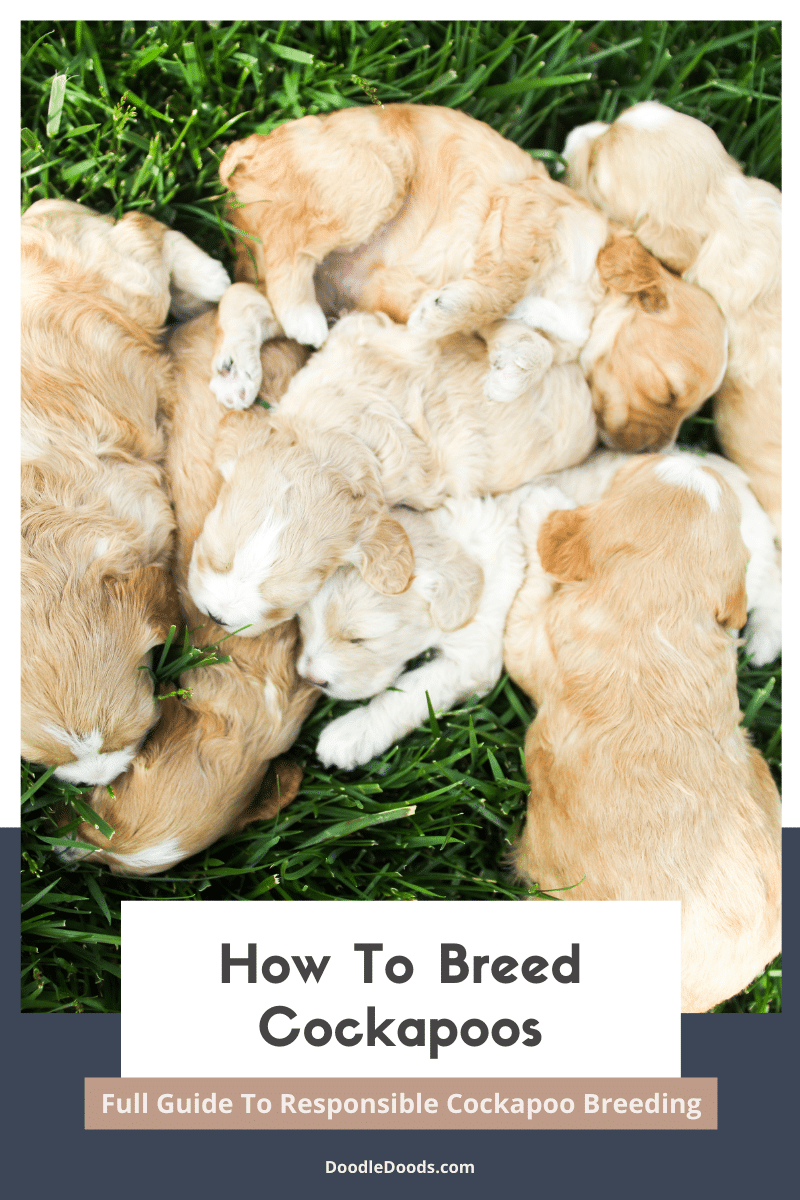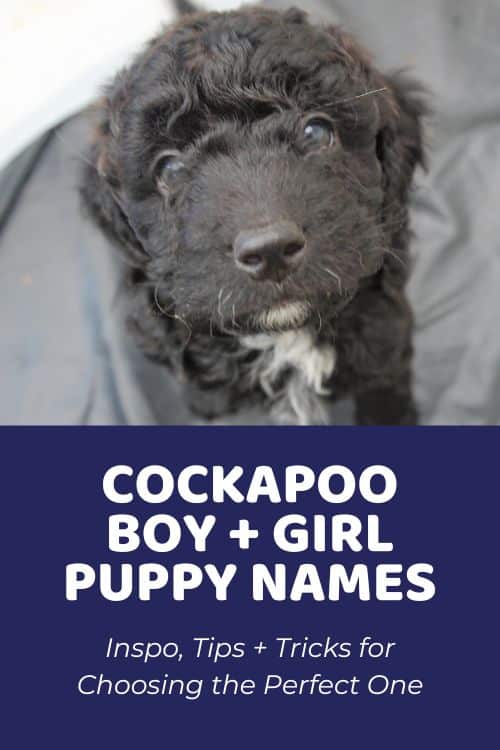Cockapoos, that quirky cross between the nation’s long-time favorite Cocker Spaniel and the “hypoallergenic” Poodle, top the list of most popular smaller-size Doodles. And these pups continue to climb in popularity as more and more people fall under their spell. So, it’s no wonder Cockapoo breeding appeals to those passionate about dogs.
If you’re thinking of breeding your Cockapoo, Cocker Spaniel, or Poodle for Cockapoo puppies so that more families can experience the magic of owning one of these loving companion animals, there’s quite a bit you’ll need to know first. The Doodle breeding business is more complex than you might think. That’s we have compiled this checklist of things to be aware of before jumping in.
Table of Contents
- Dog Breeding: A Quick Word of Caution
- Cockapoo Breeding Checklist
- Health & Genetic Screening
- Generations & Sizes
- Federal Licensing & USDA Standards
- Setup, Equipment, & Supplies
- Choosing A Suitable Mate
- Breeding & Pregnancy Care
- Birthing, Rearing The Puppies & Weaning
- Training, Socialising & Extra Services
- Advertising The Puppies & Social Media
- Following Up With The Families
- Final Thought
Dog Breeding: A Quick Word of Caution
While many owners might get the urge to breed a loving pet, be it for financial reasons because you think your dog would benefit from the experience or because you know your pup is truly special and you want to share the love, few end up doing so because it takes a fair amount of work and is hefty time commitment too. On the other hand, if you’re looking into Cockapoo breeding as a career, you might be willing to put in the time and effort but may be a little unsure of where to start.
When you’re thinking of making the work switch because you’re a genuine animal lover, the very last thing you want to come to be known as is a “backyard breeder.” While puppy mills (all for-profit breeding facilities) are the height of dog breeding poor practice, backyard breeders are their very own brand of bad – not through intention, but simply through inexperience and a lack of knowledge about their dogs.
One of the biggest issues that first-time breeders of Doodles run into is not having a clear enough understanding of how the genetics play out. This is vital because it impacts not only the health of the resulting puppies but also their size, color, and coat type – key things for potential buyers. That’s why those thinking about breeding their dog need to bone up on dog breeding best practices to ensure happy, healthy puppies that people will actually want to buy.
Cockapoo Breeding Checklist
Here is our Cockapoo breeding checklist with everything to get you up and running. While this list is by no means exhaustive, it should give you a solid foundation on which to base future research.
Health & Genetic Screening
As a breeder of Cockapoos, your biggest motivation should be to breed top-quality puppies that are not just healthy, but that actually improve the Cockapoo standard in general. One way to guarantee this will be the case is to have your breeding animals thoroughly tested for any health conditions they could pass to their offspring.
Many of the most serious canine conditions around are genetic. So before deciding whether not to make your pet a mama, you’ll need to have her health screened to ensure that she is not a carrier of diseases such as hip dysplasia, patella luxation, atopic dermatitis, or any of the other problems common to Cockapoos. These tests can be pretty pricy, which is one of the reasons Cockapoo puppies don’t come cheap.
Generations & Sizes
Cockapoos, as the original Doodles, have been around quite a bit longer than most other kinds. This means that while they haven’t quite attained pedigree-level standards of character and appearance, it is more possible to know what the puppies of these dogs will turn out like compared with more recent Doodle types. That being said, there are still plenty of different kinds.
For a start, Cockapoos come in widely varying sizes. In fact, there are four distinct types: Maxi Cockapoos, Miniature Cockapoos, Toy Cockapoos, and Teacup Cockapoos. The largest of these, the Maxi, is quite a bit bigger than you would expect from the offspring of a Cocker Spaniel. They can grow up to 22 inches to the shoulder and weigh more than 25 lbs. The smallest is very different at under 10 inches and less than 6 pounds. At present, the littler of these dogs tend to be the most popular – people like little dogs.
The other way Cockapoos differ substantially is in terms of their generation. Now, if you are already a Cockapoo owner, you will likely have already come across this term. The generation of a Cockapoo (as with all other Doodles) refers to its heritage. Unlike pedigree dogs who always have the same breed of mother and father, Cockapoos can have a fair bit of variation in their genetic makeup. They can be bred from pedigree dogs (one of each) or from Cockapoos with pedigree parents or even other Cockapoo parents. This all impacts size, appearance, temperament, and coat type.
Federal Licensing & USDA Standards
As you might expect, if you’re looking to set up a commercial breeding facility, there can be plenty of paperwork involved. In this respect, it’s a good thing because licensing and standards are in place to protect the animals. However, you will have to deal with the tricky business of figuring out which applies to you and how before thinking about breeding puppies for sale. Usually, unless you own at least four females, you won’t be subject to the licensing procedures of the U.S. Department of Agriculture (USDA)
That being said, one of the benefits of having a license or affiliations with a breeding governing body is that it inspires trust in those looking to purchase one of your puppies. So, while you may not be officially able to register your Cockapoo breeding business, it’s certainly worth looking into developing a relationship with one of the various voluntary organizations that do much the same work but for non-pedigree pups. Good Dog is perhaps one of the more well-known of these. They recommend responsible breeders that have been carefully screened to ensure they are putting the needs of their dogs first.
Setup, Equipment, & Supplies
Once you have all the legal and health provisions in place, understand the time and financial commitment involved, and are sure you want to go ahead with Cockapoo breeding, it’s time to think about what you will need to do this. First, you’ll have to set up a few things for your female to ensure she is happy and comfortable, and in the right frame of mind to be a new mom. Part of this means ensuring you have the right food with all the nutrients to support the changes her body will go through.
You’ll also need to get your hands on a whelping box. This is vital unless you are happy with your pooch picking out her idea of a perfect spot somewhere in your house. You want something big enough for her to move around comfortably but not so big that the very young puppies can move too far away from their food source. It should be easy to clean, with suitable blankets and towels for added warmth.
You should also pick up whelping supplies, including a thermometer, hemostat, gloves, stethoscope, bulb syringe, disinfectant, a scale, and something to record the puppies’ birth weight, color, and sex. Beyond that, you might have to factor in the price of some heating pads if you live in a place where it can be a little cold, as very young puppies aren’t able to regulate their own temperature.
Choosing A Suitable Mate
In going forward with the actual breeding, unless you already have a mating pair, you will need to find the right candidate. Your priority here will be the puppies’ health, so any boy dog will need to have been through the same stringent health and genetic testing as your dog. Usually, the best place to look for a “stud” is at another Cockapoo breeding facility. You’ll come up with a stud contract to cover financial and/or any other form of compensation offered for the service.
Beyond the dog’s health, you’ll also want to think about what their genes will add to the mix. You’re already going to be thinking about the size and generation of Cockapoos you wish to produce, so this will play into whether you breed your gal with a Poodle, Cocker Spaniel, or F1, F2, or F3 Cockapoo. With Cockapoos, you’ll need to ask about the dog’s heritage to determine their particular ratio of Cocker Spaniel to Poodle genes, so you know what this means for your litter.
You’ll also want to pay close attention to the dog’s temperament – you don’t want one that’s shy, anxious, or demonstrates any signs of aggression. Puppies that inherit such traits will not make great family pets. With that in mind, it’s a good idea to spend some time with the dog and any of their existing offspring if you can. From here, you should be able to develop a firm understanding of their nature.
Breeding & Pregnancy Care
With everything in place, you’ll then have to shift your attention to narrowing down your female dog’s fertility window. While they may be clearly in heat, there is a definite time during this period that they will accept a male dog, so the timing of this is especially critical. Typically breeders arrange for two meet-ups or “stud services” within a 48-hour window to guarantee a greater chance of success. Be sure to read up on what to expect, as the breeding process of dogs can seem a little strange to the uninitiated.
Once the (ahem) deed is done, you might not expect to see any early signs of pregnancy for a couple of weeks or more. Diagnostic testing cannot be relied upon until at least 28 days later. However, you may notice that your dog starts to eat more, gains a little weight, looks to have a swollen belly, tires more easily, is either more affectionate or irritable, and has larger nipples. You may even see some nesting behavior – although this is more common a little down the line.
If your pup is already eating top-quality dog food, you won’t need to worry about making changes here until the pregnancy is confirmed. Beyond this, it’s good to chat nutritional details with your vet. This will be based on your dog’s physical condition and how many puppies she might be expecting. In terms of exercise, again, you can keep things going as they are (paying close attention to signs of tiredness) until the pregnancy is noticeable. At this point, you may need to opt for more frequent, shorter walks.
Birthing, Rearing The Puppies & Weaning
Your dog will be pregnant for around 63 days, give or take a week. Understanding her due date is vital for being prepared, so ask your vet about this. During this time, get her used to the whelping box, making sure it’s in a warm and cozy place where she can rest undisturbed. All this makes it more likely that come the time; your pal will choose this spot for birthing.
When it comes time for whelping, if you can enlist the services of an experienced breeder to oversee the process, just the first time, more’s the better. They can help you know what to expect, keep an eye out for any issues and help the mother out where needed. You should also keep the number of your vet and the nearest emergency, out-of-hours clinic handy, just in case. Typically, the mother should be able to take care of most of the birthing, and you should try to handle the new puppies as little as possible.
In those first few days, you’ll have little to do besides ensuring the puppies feed and stay warm. Keep a close eye on their weight gain to ensure no one falls behind. After around three to four weeks, the momma will leave her puppies for longer, and you’ll know it’s time to begin the weaning process. Start with reconstituted puppy milk replacers. After a few days, you can offer the puppies specifically formulated puppy food mixed in with the replacer and then just the puppy food – and you’ll be away.
Training, Socialising & Extra Services
Alongside caring for the puppies and working through the weaning process, you have a few other responsibilities as a Cockapoo breeder. You’ll need to get the puppies’ vet checked to ensure they are healthy. Beyond that, you’ll have to figure out vaccinations, deworming, and microchipping. This way, you can be sure that the puppies are in the best possible physical health before they go to their new homes.
Taking care of the puppies’ mental and behavioral development is also vital. While they’ll receive their early lessons about being a dog from their mom and littermates, you’ll need to step in to show them the ways of the world around them. Early Neurological Stimulation (ENS) is an excellent place to start. Basically, this is a way of introducing very young dogs to stimulations and stressors to kickstart their natural coping abilities and enhance their neurological development.
Additionally, early socialization is critical for creating mellow, chilled-out pups that make perfect pets. This involves handling them regularly and gradually getting them used to new aspects of their environment, including children and other dogs/animals. These are the fundamentals of getting the puppies ready for adoption. Beyond that, better facilities offer early training, including toilet and crate training and even puppy programs for slightly older dogs.
Advertising The Puppies & Social Media
Getting word out about your puppies should start ahead of their birth. This gives you plenty of time to establish yourself as a Cockapoo breeder, track down interested parties and screen them to ensure their suitability. A company website gives your operation an air of professionalism, and social media is great for directing people to your site.
In a time where more and more people are being scammed by chancers looking to profit from the rise of the dog breeding industry, it’s crucial to build your public trust factor. Not only should you be open and transparent on the details of your breeding dogs, but photos, videos, and (perhaps most importantly) testimonials from those who know your dogs – and later families who have adopted one of your puppies are key.
Following Up With The Families
Finding the right families for your puppies will be at the top of your priority list, but for the very best breeders, responsibility for their puppies doesn’t end there. Alongside a health guarantee, which is a proviso of the purchasing contract that states that if any hereditary conditions are discovered within a certain period, the purchaser can return the puppy and get a full refund, many offer lifelong support, advice, and guidance with their puppies.
The biggest part of this is positioning yourself as a Cockapoo expert. You’ll need to be able to answer questions about milestones, such as teething, and advice on behavioral issues. Plus, providing recommendations for foods, toys, and other things canine will set you apart and establish your reputation as a Cockapoo breeder. Beyond that, satisfied customers will spread the word, which is the very best way to see your business grow.
Final Thought
There’s much to know if you’re looking to breed Cockapoo puppies, whether just once or as an established Cockapoo breeder. Not only will you need to read up on Cockapoo breeding practices, but you’ll also need a clear understanding of how genetics play out when breeding dissimilar dogs. You’ll also need to create the perfect environment for breeding, whelping, weaning, training, and everything else your puppies will need in their earliest days. Hopefully, this article has given you some ideas of what to expect before you plunge into the challenging but deeply satisfying world of Cockapoo breeding.
Learn How to Care for Your Doodle Puppy!

Perfect for first-time Doodle parents, get ALL your questions answered, including questions new Doodle parents don’t even think to ask.
Plus, get $700 worth of Bonus Materials for FREE, including:- Doodle Parenthood Community and Support Group ($190 value)
- Doodle Puppy Growth Tracker ($20 value)
- EMERGENCY Cheatsheet: When To Call The Vet Immediately ($50 value)
- HELP! Button ($145 value)
- And SO MUCH MORE!














As a breeder, have you considered the emotional impact of caring for pregnant Doodles, including potential complications and the responsibility of ensuring the health and safety of both the mother and puppies?
July 29, 2024 at 11:40 am